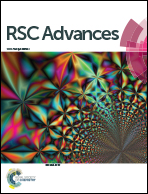Studies on the effects of different multiwalled carbon nanotube functionalization techniques on the properties of bio-based hybrid non-isocyanate polyurethane
Abstract
A novel synthesis method for multiwalled carbon nanotube (MWCNT) modified bio-based hybrid non-isocyanate polyurethane (HNIPU) is proposed in this paper. Modification methods for several properties of MWCNTs–HNIPU were systematically studied. MWCNTs were grafted with carboxyl and amino groups using a condensation reflux device. Au nanoparticles were synthesized on the surface of the MWCNTs via a reduction reaction and Fe3O4 particles were decorated on the MWCNTs using a hydrothermal method. FTIR, TEM, XRD, XPS and Raman techniques were employed to confirm the compositions and structures. Then, five different types of MWCNT were utilized for blending with non-isocyanate polyurethane (NIPU) via solution methods. After curing with epoxy resin E-51, the cross-linked composites were applied as coatings. A series of tests demonstrated that HNIPU composited with MWCNTs–COOH–Au had the highest Tg value, the best thermal, thermodynamic and mechanical properties, and excellent pencil hardness, adhesion, flexibility and impact strength, while HNIPU composited with MWCNTs–COOH–NH2 had the best water absorption and swelling properties. These results showed that the properties of hybrid non-isocyanate polyurethane can be adjusted via different MWCNT surface modification approaches or the addition of nanoparticles, so this kind of polyurethane has a vast development space for coating applications.



 Please wait while we load your content...
Please wait while we load your content...